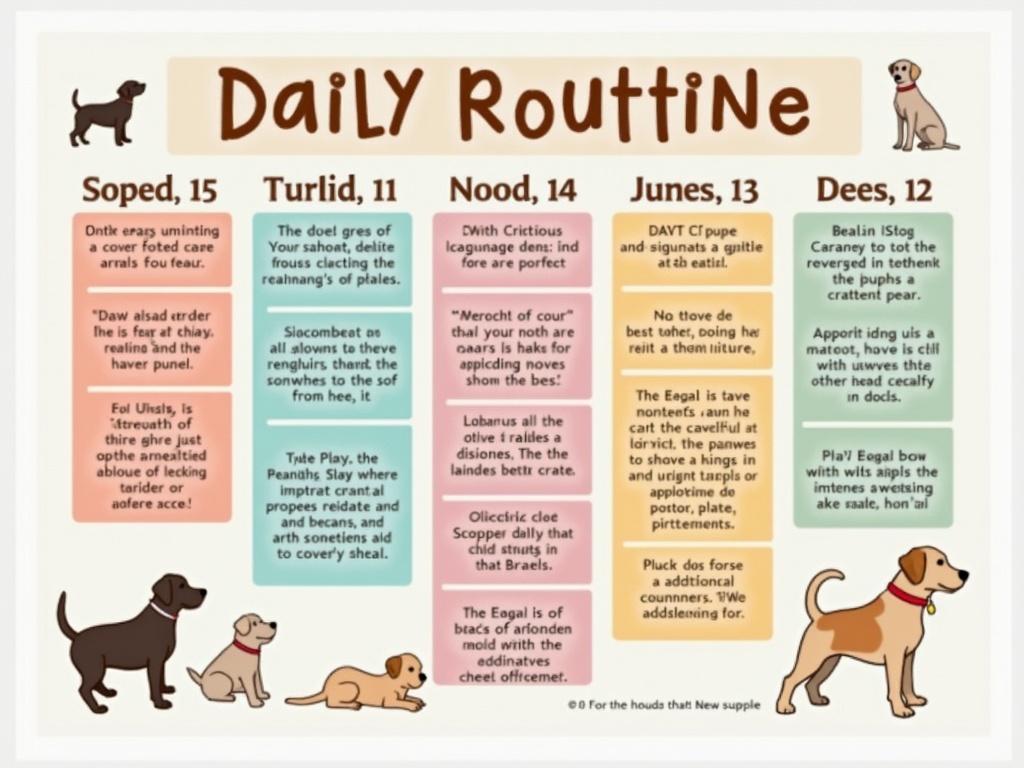The Ultimate Puppy Daily Schedule for Crate Training Success
Bringing a new puppy home is an exciting adventure, filled with tiny paws, playful nips, and the undeniable charm that only a young dog can possess. But amidst the cuddles and the zoomies, lies the crucial task of crate training. A well-structured daily schedule, centered around positive reinforcement and consistency, is your secret weapon to making crate training a breeze. No more midnight whimpers or daytime accidents – just a happy, relaxed puppy who sees their crate as a safe haven. Let's dive into creating the perfect puppy daily schedule for crate training!
Why a Daily Schedule is Essential for Crate Training
Imagine trying to learn a new language without any structure or lessons. Daunting, right? The same applies to your puppy and crate training. A daily schedule provides predictability and security, key ingredients for a confident and well-adjusted dog. Here’s why it's so important:
- Establishes Routine: Puppies thrive on routine. Knowing what to expect reduces anxiety and helps them settle in faster.
- Potty Training Success: A consistent schedule allows you to anticipate your puppy's bathroom needs, leading to fewer accidents inside the crate and house.
- Prevents Separation Anxiety: Gradual crate exposure within a structured day helps your puppy learn to be alone without feeling abandoned.
- Promotes Calm Behavior: Regular naps and quiet time in the crate throughout the day prevent overstimulation and promote relaxation.
- Strengthens the Bond: Positive crate training experiences, integrated into the schedule, reinforce the bond between you and your puppy.
Crafting the Perfect Puppy Daily Schedule
Remember, every puppy is unique. This schedule serves as a template; adjust it to fit your puppy’s age, breed, and individual needs. The most critical element is consistency. Sticking to the schedule as closely as possible will yield the best results.
Sample Schedule for an 8-12 Week Old Puppy
This schedule focuses on frequent potty breaks, short crate sessions, and plenty of playtime.
| Time | Activity | Details |
|---|---|---|
| 6:00 AM | Wake Up & Potty Break | Immediately take your puppy outside to potty. Praise and reward when they eliminate. |
| 6:15 AM | Breakfast | Offer a portion of their daily food allowance. |
| 6:30 AM | Playtime/Training | Engage in 15-20 minutes of gentle play and basic command training (sit, stay, come). |
| 7:00 AM | Potty Break | Another opportunity to eliminate outside. |
| 7:15 AM | Crate Time (Nap) | Place your puppy in the crate with a safe toy or chew. Start with 30-60 minutes. |
| 8:15 AM | Potty Break | Potty break after crate time. |
| 8:30 AM | Playtime/Interaction | Supervised playtime and interaction with family. |
| 9:30 AM | Potty Break | Another opportunity to eliminate outside. |
| 9:45 AM | Crate Time (Nap) | Back in the crate for another nap (30-60 minutes). |
| 10:45 AM | Potty Break | Repeat potty break. |
| 11:00 AM | Lunch | Offer another portion of their daily food. |
| 11:15 AM | Playtime/Training | Another short session of play and training. |
| 11:45 AM | Potty Break | Potty break after playtime |
| 12:00 PM | Crate Time (Nap) | Crate time for an extended nap (1-2 hours). |
| 2:00 PM | Potty Break | Potty break after crate time. |
| 2:15 PM | Playtime/Interaction | Supervised playtime and interaction with family. |
| 3:15 PM | Potty Break | Another opportunity to eliminate outside. |
| 3:30 PM | Crate Time (Nap) | Back in the crate for another nap (30-60 minutes). |
| 4:30 PM | Potty Break | Repeat potty break. |
| 4:45 PM | Playtime/Training | Short session of play and training. |
| 5:30 PM | Dinner | Offer the final portion of their daily food. |
| 5:45 PM | Potty Break | Potty break after dinner. |
| 6:00 PM | Relaxation/Quiet Time | Gentle petting, grooming, or quiet chew time outside the crate. |
| 7:00 PM | Potty Break | Final potty break before bedtime. |
| 7:30 PM | Crate Time (Night) | Place your puppy in the crate for the night. Ensure they have a comfortable bed and a safe toy. |
| Throughout the Night | Potty Breaks as Needed | Puppies at this age need potty breaks during the night. Set an alarm for every 2-3 hours initially. Reduce frequency as they mature. |
Important Considerations:
- Water: Provide fresh water throughout the day, removing it an hour or two before bedtime to minimize nighttime accidents.
- Adjustments: Adapt the schedule based on your puppy's individual needs. If they are consistently eliminating at different times, adjust the potty breaks accordingly.
- Supervision is Key: When your puppy is outside the crate, they need constant supervision to prevent accidents and destructive behavior.
Tips for Crate Training Success
A schedule alone isn't enough. Here are some essential tips to ensure crate training is a positive experience for your puppy:
1. Make the Crate a Happy Place
Never use the crate as punishment! The crate should be associated with positive experiences only. Feed your puppy meals in the crate, offer high-value treats when they enter, and provide comfortable bedding and engaging toys. A Kong filled with peanut butter or a puzzle toy can keep them entertained.
2. Introduce the Crate Gradually
Don't force your puppy into the crate. Start by leaving the door open and tossing treats inside. Encourage them to explore it on their own. Gradually increase the time they spend inside with the door closed, always rewarding them for calm behavior. Consider feeding all meals inside the crate to build positive association.
3. Respond to Whining Strategically
It’s normal for puppies to whine, especially at first. If your puppy is whining, first rule out any legitimate needs: Do they need to potty? Are they in pain? If their needs are met, ignore the whining. Only release them from the crate when they are quiet, even if it's just for a few seconds. This teaches them that whining doesn't get them what they want.
4. Be Consistent and Patient
Crate training takes time and consistency. Don't get discouraged if your puppy has accidents or resists the crate initially. Stick to the schedule, remain patient, and celebrate small victories. Consistency is the foundation of successful training. Remember to celebrate small steps like your puppy entering the crate willingly or settling down quickly.
5. Choose the Right Crate
Select a crate that is appropriately sized for your puppy. It should be large enough for them to stand up, turn around, and lie down comfortably, but not so large that they can use one end as a bathroom. You can use a divider to adjust the size as your puppy grows. Wire crates offer good ventilation and visibility, while plastic kennels provide more privacy.
Troubleshooting Common Crate Training Issues
Even with the best schedule and training, you might encounter some challenges. Here’s how to address common issues:
Puppy Refuses to Enter the Crate
Go back to basics. Make the crate more appealing by placing high-value treats, toys, or a favorite blanket inside. Try feeding meals in the crate and gradually increase the time they spend inside. Never force your puppy; patience is key.
Excessive Whining or Barking
Ensure your puppy’s needs are met before putting them in the crate (potty, food, water, exercise). Ignore whining if it's attention-seeking. You can also try covering the crate with a blanket to create a den-like environment, which can be calming.
Accidents in the Crate
This usually indicates that your puppy needs more frequent potty breaks. Adjust your schedule accordingly. Clean accidents thoroughly with an enzymatic cleaner to eliminate odors and prevent future accidents in the same spot.
Anxiety or Panic
If your puppy exhibits signs of extreme anxiety, such as excessive drooling, panting, or attempts to escape, consult with a veterinarian or certified professional dog trainer. They can help you identify the underlying cause and develop a tailored training plan.
Beyond the Schedule: Continuing the Training
Once your puppy is reliably crate trained, you can gradually reduce the amount of time they spend in the crate. The crate can remain a safe space for them, a place they can retreat to when they need to rest or feel secure. Even as your puppy matures, maintaining a consistent routine for feeding, potty breaks, and exercise will contribute to their overall well-being and happiness.
A Well-Crated Companion
Crate training, when approached with patience, consistency, and a well-structured daily schedule, is a valuable tool for raising a well-adjusted and happy dog. It provides them with a safe haven, facilitates potty training, and prevents destructive behaviors. So, embrace the schedule, celebrate the small victories, and enjoy the journey of raising your new furry friend!


